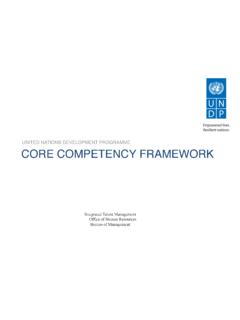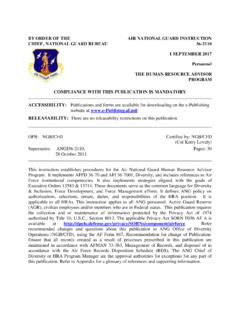Transcription of Steps in Developing a Recruiting Strategy: Part 1 of 2
1 Ascentii Steps in Developing a Recruiting strategy : part 1 of 2 From time to time Ascentii Executive Placement Solutions selects whitepapers and articles from external thought-leaders. This newsletter presents Recruiting Managers, Do You Really Have a Recruiting strategy ? by Dr. John Sullivan published in on Monday, November 15, 2004. More information on Dr. Sullivan s work can be viewed at Dr. Sullivan is also the editor of VP of HR, an e-newsletter providing "out of the box" solutions for senior HR managers. Free subscriptions can be obtained on his website. Introduction When I meet with directors or managers of corporate Recruiting , I routinely ask them a simple question: "What is the name of your Recruiting strategy ?" Almost without fail, I get one of two basic responses, either, "We hire great people," or a just blank look.
2 The first is a horrible answer in that it's not really a Recruiting strategy as much as it is a goal or bland statement. It fails to identify where and when you recruit these "great people," and how you identify them. It also provides no differentiation, because clearly no organization (other than perhaps the DMV) starts out trying to hire "bad people." The blank look is unfortunately the most common response. I used to be shocked when it happened over and over, but I've grown accustomed to the fact that most Recruiting departments not only don't have a name for their strategy , they have no strategy at all. Keep in mind that these are not line-level recruiters, but Recruiting managers, the same individuals who frequently exclaim in meetings that they want the Recruiting function to be more strategic. The simple fact is you can't be strategic without having a clearly defined strategy .
3 Now, I happen to think I know a little bit about strategy . As an advisor, I have helped design strategies for a number of leading corporations in the area of human resources and staffing in particular; I teach strategy to business students at the university level; and I have written a book on HR strategy (Rethinking HR strategy ) that many business leaders have adopted as a bible for new HR. All of my thoughts and knowledge on strategy were formed via observations made during my three plus decades in human resources. During this time I have been continually shocked by the number of Recruiting professionals who: Can't even define the term " strategy " Don't know the available strategies in Recruiting Don't have a name for their own Recruiting strategy Don't know the Steps involved in preparing a Recruiting strategy Have never written down their strategy so that others can follow it Ascentii Have never compared their strategy in Recruiting to their competitors' Recruiting strategies in order to ensure that theirs is superior Have never integrated their strategy with their recruiter selection, budgeting, and time allocation processes Make no attempt to measure the effectiveness of their Recruiting strategy What Exactly Is a strategy ?
4 The basic premise of having a clearly defined strategy is that by focusing your efforts and looking at the big picture, the Recruiting function is more likely to meet its stated goals and have a significantly larger economic impact on the business. Having a clearly defined strategy sets up an architecture to focus your efforts and planning beyond basic tactical Recruiting and towards establishing a competitive advantage in Recruiting . The strategy focuses the actions of a Recruiting department, telling everyone what to concentrate on and what is unimportant. It further drives whom you hire as recruiters and how you allocate your budget and your time. Academic definition of strategy : "The plans made or the actions taken in an effort to help the organization fulfill its intended purpose." From a practical standpoint, being strategic includes these elements: Establishing a competitive advantage.
5 The primary goal of a strategy is to drive actions that gain your firm a sustainable competitive advantage in your industry. It demands an ongoing competitive analysis of major "talent competitors" and adjusting of strategy to keep competitors from mirroring or one-upping current Recruiting efforts. Demonstrating economic impact. Strategic impact is measured in profit, stock value, return on investment (ROI), increased revenue, higher market share and increased margins. Company-wide impact. Strategic departments have a measurable, company-wide impact, well outside their function. Big picture approach. Strategic means taking a big picture approach. It's global and it looks beyond the current boundaries of business practice. It does not deal with day-to-day issues (operations). Future focused. Strategic functions are future focused.
6 They anticipate and prepare for a range of possible occurrences. They rely on extensive information gathering and forecasting of the business environment. Continually evolving. Being strategic means continually evolving and reacting to any change in the environment. It requires you be proactive and aggressive. If requires that you seek out problems and opportunities. Data driven. Strategic functions rely heavily on the analysis of data and the measurement of outcomes. A way of thinking. Being strategic is as much a way of thinking as it is a way of managing. Ascentii What Are the Available Recruiting Strategies? As I mentioned earlier, most firms don't have a documented or formal Recruiting strategy . There are notable exceptions, such as Southwest Airlines, which is famous for hiring personality and training for skill.
7 Microsoft is famous for hiring "brains," intellectuals with a proven ability to solve complex logical problems that may or may not have experience in technology. Google seeks out candidates that think outside the box, not necessary how to accomplish something, but rather what all the possibilities are. These are all well-known, oversimplified examples of corporate strategies, but they serve to illustrate the fact that leading companies have strategies that are completely differentiated from others. In fact, strategies cannot be defined with a single word. Recruiting strategies are complex and may contain up to 12 distinct elements. The 12 elements of a Recruiting strategy are listed below. In order to develop a complete Recruiting strategy must select one or more items from each of the twelve elements. Those elements include: The primary goals of Recruiting The prioritization of jobs The performance level to target The experience level to target The employment status of the candidate to target When to search Where to search Who does the Recruiting Primary sourcing tools What skills to assess How to assess skills Primary selling points to offer An Example of a Comprehensive Recruiting strategy Description Comprehensive Recruiting strategies cannot be accurately covered in with a single word or even a simple phrase.
8 Before you can put a name on your strategy , you first need to make a variety of decisions within each of the 12 different strategy elements. The net result is a strategy that might, for example, sound something like this: An external, hire-to-learn strategy targeting top performers: Our strategy is a skill-building, "hire to learn" strategy focusing on hiring experienced top performers (who are currently employed by competitors) into pre-identified key jobs. Our strategy employs a pre-need, external "within the industry" search that primarily utilizes sourcing and Recruiting specialists. A branding strategy and employee referral program are utilized to attract candidates. Candidates are selected primarily through interviews that screen candidates for pre-identified corporate competencies. The primary "candidates selling" approach is a great culture and proven learning and growth opportunities.
9 Ascentii The 12 Essential Elements of a Comprehensive Recruiting strategy 1. What are your primary goals? (Why hire?) The first element of Recruiting strategy is to determine "why" you are hiring outside people. First, you must determine your firm's business goals and then what Recruiting can do to contribute to each of them. Some of the more common business reasons for hiring include: Replacements for turnover Current or future business expansion Upsizing the caliber of talent because top talent has become available Limiting the talent available in the market in order to hurt a competitor's ability to staff adequately Learning from other firms Increasing the capability of your firm by adding new skill sets Which of these focus areas you select is important because each requires that you direct your Recruiting efforts in a different way.
10 For example, if you are hiring for geographic expansion, you will need to implement a strategy that allows you to enter new geographic regions -- as opposed to hiring to hurt, where you need to focus on hiring away key talent directly from competitors. 2. Prioritization of Jobs No Recruiting function has enough resources to fill every position immediately with the top quality hire. As a result, your Recruiting strategy needs to include a prioritization element. Priority can be assigned in the following ways: Hire all jobs equally with the same priority Focus on key strategic business units Focus on key jobs Focus on key or powerful managers 3. Performance Level to Target Recruiting top performers requires a different strategy and set of tools than Recruiting average performers. As a result, you must first determine what level of performance you are primarily targeting before you determine the other elements of your Recruiting strategy .








